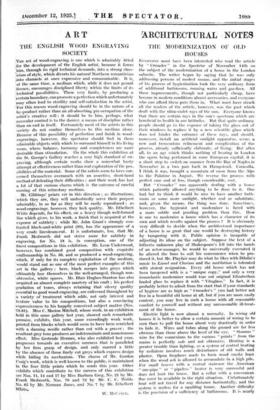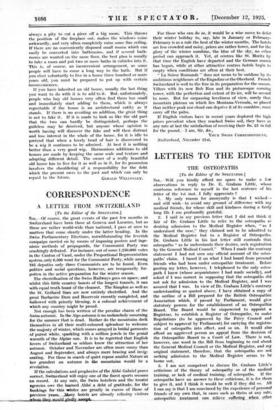ARCHITECTURAL NOTES
THE MODERNIZATION OF OLD HOUSES
EVERYONE must have been interested who read the article by " Crusader " in the Spectator of November 14th on
the subject of the modernization of a house in the London suburbs. The writer began by saying that he was only addressing persons of modest means, and the initial stages of his process of hygienization took the very ordinary form of additional bathrooms, running water and gas-fires. All these improvements, though not particularly cheap, have become in modern conditions almost necessaries, and everyone who can afford them puts them in. What must have struck all the readers of the article, however, was the part which dealt with the ultra-violet rays of the sun. Everyone knows that there are certain rays in the sun's spectrum which are beneficial to health in our latitudes. But that quite ordinary people should go to the expense of taking the glass out of their windows to replace it by a new scientific glass which does not hinder the entrance of these rays, and should, moreover, install an artificial sunlight apparatus, seems a new and tremendous refinement and complication of the process, already sufficiently elaborate, of living. But after all, to an age which thinks nothing of hearing in London the opera being performed in some European capital, it is a short step to switch on summer from the Bay of Naples in November in a two pair back in Hampstead. Caracalla, I think it was, brought a mountain of snow from the Alps to the Palatine in August. We reverse the process with perfect ease and at less, though considerable, cost.
But " Crusader " was apparently dealing with a house which patiently allowed anything to be done to it. One had but to think it would be nice to have another bath- room or some more sunlight, whether real or substitute, and, given the means, the thing was done. Sometimes, however, the hygienist and modernizer is faced with a more subtle and puzzling probleM than this. How is one to modernize a house which has a character of its own and which revolts against the process ? It is obviously very difficult to decide when the architectural importance of a house is so great that one would be destroying history by tampering with it. Public opinion is incapable of adjusting its ideas on the subject. Suppose the text of a hitherto unknown play of Shakespeare's fell into the hands of an actor-manager, he would be universally execrated if he altered the lines to suit his convenience when he pro- duced it, but Mr. Playfair may do what he likes with Dibdin's music to Lionel and Clarissa and the mutilation is tolerated with stoical resignation. Every old house which has not been tampered with is a " unique copy," and only a very iconoclastic modernizer would tear out original Elizabethan leaded glass to replace it with " Vitaglass." In fact, it is probably better to admit from the start that if your standards of hygiene are as high as " Crusader's ". you had better not live in a beautiful old house at all, but if you are more easily content, you may live in such a house with all reasonable comfort to yourself and without any unreasonable ill-treat. ment of the house.
Electric light is now almost a necessity. In wiring old houses it is better to allow a certain amount of wiring to be
seen than to pull the house about very drastically in order to hide it. Wires and tubes along the ground are fur less obvious than those above the level of the eye. " Stannus " wire for the connexions to the various " points " from the mains is perfectly safe and not obtrusive. Heating is a greater trouble than lighting, us a system of central heating by radiators involves much disturbance of old walls and plaster. Open fireplaces made to burn wood smoke least when the wood ash is allowed to accumulate in a high. pile. For small houses with a central staircase the .American " one-pipe " or " pipeless " heater is very successful and does not hurt the house. But a cellar with a convenient flue must be available in the right situation. Unfortunately heat will not travel for any distance horizontally, and the system is useless for a rambling house., Another difficulty is the provision of a sufficiency of bathrooms. It is nearly always a pity to cut a piece off a big room. This throws the position of the fireplace out, makes the windows come awkwardly, and very often completely ruins some-fine-ceiling. If there are no conveniently disposed small rooms which can easily be converted into bathrooms, and if several bath- rooms are wanted on the same floor, the best plan is usually to take a room and put two or more baths in cubicles into it. This is, of course, an inconvenient arrangement, as some people will have to come a long way to the bath. But if you elect voluntarily to live in a house three hundred or more years old, you must be prepared to put up with certain inconveniences.
- If you have inherited an old house, usually the last thing you want to do with it is to add to it. But, unfortunately, people who buy old houses very often find them 'too small and immediately start adding to them, which is- ahiayS regrettable if the house is an architectural entity as it stands. If there is no avoiding an addition, the great thing is not to fake it. If it is made to look so like the old part that the two can hardly be distinguished, perhaps the guileless may be deceived, but anyone whose opinion is Worth having will discover the fake and will then distrust and loSe interest in the whole of the house, for it is idle to pretend that when a lovely head of hair is discovered to be a wig it continues to be admired. At best it is nothing better than a very good wig. Harmonious additions to old houses are made by--keeping the same scale and texture and adopting different detail. The owner of a really beautiful old house hai to live for it as well as in it, for its possession involves the shouldering of a responsibility for the debt which the present owes to the past and which can only be























































 Previous page
Previous page